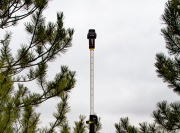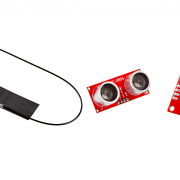Hacker-in-Residence: Flying Robots
John Gillespie joins us from Texas for two weeks of hackery!
By now, our Hacker-in-Residence program is humming right along, and we mostly stand around tapping our fingers together with glee while some excellent applications roll in. One such excellent application came from our new friend John Gillespie, and we're happy to have him join us for the next two weeks!
John's favorite movie is "The Adventures of Buckaroo Banzai Across the 8th Dimension," his favorite snack is yogurt-covered raisins, and he claims he can win any carnival game you put in front of him, as long as it's not rigged. Important statistics aside, we also asked John about his background and plans for his residency.
Tell us your background, interests, and some favorite past projects. What and where is your current position/company?
My background is in mechanical engineering and programming. I am married with three kids and live in a tiny town in the Texas hill country. I am the founder & lead developer for a small mobile development company - Product7. I have been developing for the iPhone for over four years - I have over 20 apps in the Apple app store - mainly in the education market.
A recent fun project I worked on was at the AngelHack mobile AppHack in Austin, TX, in early November. I won 2nd place with ShareMesh – an iOS based encrypted peer to peer messaging app that does not require an internet connection to operate. The app used the new iOS 7 features iBeacon and Multipeer Connectivity to handle discovery and communication between devices. I had a great time and there were a lot of interesting projects and very talented people working on them.
How and why did you get involved in SparkFun's Hacker in Residence program? Why do you think programs like this hacker-in-residence are valuable?
I think the next big thing is the intersection and hardware and software (internet of things), and I am very interested in robotics and the DIY drone & UAV efforts, especially those based around the Arduino. I love writing code but I am definitely a newbie with regards to hardware projects. I have been using SparkFun products and tutorials to help me ramp up on electronics and the Arduino over the past few months. I saw the Hacker in Residence program and applied - the biggest benefit to me is the access to SparkFun's expert engineers and resources, plus the time and focus to start and finish my project.
What is the project you'll be working on at SparkFun, and how long will you be here? Why did you choose this project?
I want to create a single propeller flying UAV that is as maneuverable and stable as a quadcopter. The single larger rotor is more efficient, quieter, and should be cheaper to build as well. I'll use software and aerodynamic forces (ailerons & rudders) to keep the single prop design stable in hover.
I chose this project because I am very interested in solving real world problems with 'swarms' of simple flying robots. Before doing that I need to as a first step to design extremely low cost basic flying robots that eventually will work together to perform tasks in the real world. I'd like to see the world of robotics focus on generic, modular, and cheap hardware that can be re-configured by software on the fly to handle different conditions and/or tasks - instead of expensive hardware customized for every task.
My initial goals are to develop a single rotor 'tail sitter' UAV that can sit in stable hover indoors at a designated altitude over the floor with no user input (software controlled), and to update code/hardware to handle external inputs (wind from a fan, push from person) and regain stability. My stretch goals are to create code/hardware so that the drone will follow the user (without obstacle avoidance) within a certain distance, probably using iOS beacon tech (Bluetooth LE).
We're excited to have John here and can't wait to see what he ends up building. If you'd like to apply to be a SparkFun Hacker-in-Residence, you can apply here!









